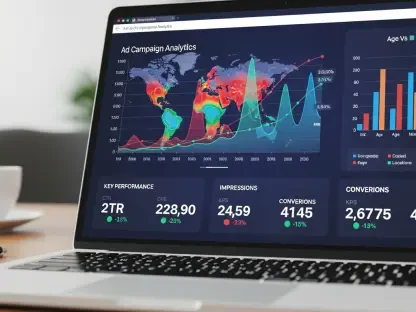As we dive into the ever-evolving world of digital marketing analytics, I’m thrilled to sit down with Anastasia Braitsik, a global leader in SEO, content marketing, and data analytics. With her extensive experience navigating complex tools like Google Analytics 4 (GA4), Anastasia offers unparalleled insights into how this platform has transformed marketing strategies over the past five years. In this conversation, we explore the profound impact of GA4 on modern marketing, the challenges of transitioning to its event-based model, the influence of privacy regulations, the value of recent updates, and its tailored applications across industries. Join us as we unpack the successes, struggles, and future potential of GA4 through the lens of an expert who’s seen it all.
How has Google Analytics 4 shaped the landscape of marketing analytics five years after its full rollout?
I’d say GA4 has fundamentally changed how we approach marketing analytics by shifting the focus from traditional session-based tracking to a more flexible, event-based model. This allows us to capture user interactions across websites and apps in a unified way, which is huge for understanding the full customer journey. Five years in, it’s become a cornerstone for predictive analytics, leveraging machine learning to offer insights that were unimaginable with Universal Analytics. That said, it hasn’t been a smooth ride for everyone—there’s still friction in fully harnessing its power due to its complexity.
What do you see as the most significant strengths of GA4 for marketers today, and where do you think it still needs improvement?
GA4’s biggest strength is its ability to provide deeper, more actionable insights through features like automated event tracking and integration with BigQuery for advanced data analysis. These tools empower marketers to move beyond surface-level metrics and really dig into user behavior. However, it’s not perfect. The learning curve is steep, and even in 2025, I see teams struggling with the interface and custom reporting. There’s also room for better guidance on privacy compliance within the platform itself—it’s still a bit of a puzzle to navigate.
Can you share some of the biggest challenges you faced when transitioning from Universal Analytics to GA4?
The transition was honestly a headache for many of us. One of the biggest challenges was the data discrepancy between Universal Analytics and GA4—metrics didn’t align, and historical comparisons were tough to make. We had to rebuild reports from the ground up, which took significant time and resources. Plus, the shift to an event-driven model meant rethinking how we defined and tracked key actions. It wasn’t just a technical switch; it required a complete mindset change for my team.
How did you tackle the issue of data accuracy during that transition period?
Data accuracy was a major concern early on. We started by auditing our existing setups in Universal Analytics to understand what we were tracking and why. Then, we mapped those to GA4’s event structure, ensuring we weren’t missing critical interactions. We also ran both systems in parallel for a while to spot inconsistencies and adjust. Honestly, it was a lot of trial and error, but setting up detailed documentation and involving the whole team in testing helped us rebuild trust in the numbers over time.
Why do you think so many businesses were slow to adopt GA4, even as late as 2023 when Universal Analytics was phasing out?
A lot of businesses dragged their feet because the transition felt overwhelming. GA4 wasn’t just an update—it was a complete overhaul with a new way of thinking about data. Smaller companies, in particular, often lacked the resources or in-house expertise to make the switch quickly. There was also a lot of uncertainty around data continuity and whether GA4 would deliver the same reliability as Universal Analytics. Fear of losing historical data or misconfiguring setups kept many on the sidelines until the last minute.
With adoption much higher now in 2025, are there still lingering struggles with GA4’s complexity that you’ve noticed?
Absolutely, complexity remains a sticking point. Even with broader adoption, I see organizations wrestling with customizing reports or fully utilizing advanced features like predictive audiences. The interface can be intimidating, and without proper training, teams often stick to basic metrics instead of exploring GA4’s full potential. There’s also ongoing confusion around event setup—getting that wrong can skew everything. It’s clear that ongoing education is critical to close these gaps.
How have privacy regulations like GDPR and CCPA influenced the way you use GA4 in your marketing efforts?
Privacy laws have forced us to rethink data collection entirely. With GDPR and CCPA, we’ve had to prioritize consent-based tracking, which means less data to work with in GA4 compared to the old days. We’ve had to lean on features like anonymized IP tracking and ensure we’re transparent about what we collect. It’s restricted some of our granularity, but it’s also pushed us to focus on quality over quantity in the insights we derive from user behavior.
What specific adjustments have you made to balance detailed analytics with compliance to these privacy rules?
We’ve made several adjustments, starting with implementing robust consent management platforms to integrate with GA4. This ensures we’re only tracking users who’ve opted in. We’ve also shifted toward aggregated data and leaned on GA4’s machine learning to fill in gaps where individual-level data isn’t available. Additionally, we regularly audit our data practices to stay compliant while still pulling meaningful insights. It’s a tightrope walk, but it’s doable with the right processes in place.
Which of GA4’s features, like automated event tracking or BigQuery integration, have had the most impact on your work, and why?
Automated event tracking has been a game-changer for me. It saves so much time by capturing key interactions without manual setup, letting us focus on analysis rather than configuration. BigQuery integration is also huge for larger datasets—it allows us to run complex queries and blend GA4 data with other sources for a more holistic view. Both features have streamlined our workflows and let us uncover insights that would’ve been buried otherwise.
Have the 2025 updates, such as enhanced annotations and AI-generated insights, made a noticeable difference in how you use GA4?
Yes, the 2025 updates have been pretty impactful. Enhanced annotations help us quickly contextualize data spikes or drops, which is invaluable for troubleshooting or spotting trends. The AI-generated insights are also a nice touch—they surface patterns we might’ve missed, especially when juggling multiple projects. These updates don’t solve every problem, but they’ve definitely made day-to-day analysis more efficient and less prone to human oversight.
Can you walk us through an example of how you’ve used GA4 to personalize experiences or drive results in a specific industry?
Sure, in the hospitality sector, we’ve used GA4 to tailor guest experiences by analyzing engagement metrics and traffic sources. For one hotel chain, we tracked how users interacted with their booking funnel and noticed drop-offs at specific steps. Using GA4’s data, we segmented audiences based on behavior and referral channels, then integrated that with their CRM to send personalized offers. This led to a noticeable uptick in conversions. It’s a great example of how GA4 can turn raw data into targeted action.
What is your forecast for the future of GA4 and its role in the broader marketing analytics landscape?
I see GA4 continuing to evolve as the backbone of marketing analytics, especially with its focus on AI and cross-platform tracking. As privacy concerns grow, I expect Google to double down on consent-driven models and synthetic data to fill gaps. I also think we’ll see tighter integration with other tools for seamless workflows. My forecast is that GA4 will push marketers to prioritize adaptability—those who master it will thrive, while others risk falling behind in an increasingly data-driven world.









